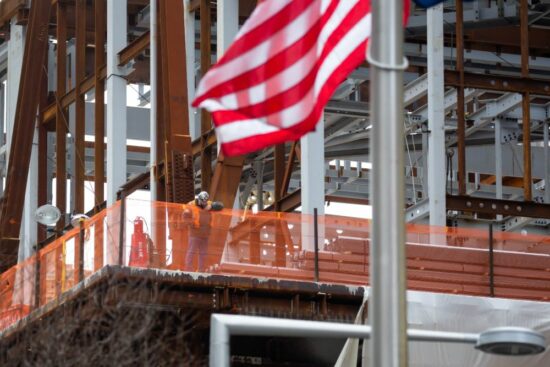February 11th local time, the U.S. Department of Labor released data that the number of first-time jobless claims in the United States last week was 793,000, more than the market expected 760,000.
The analysis suggests that there is still a long way to go for the recovery of the U.S. labor market, and also justifies the Biden administration to implement a large-scale rescue plan.
Even so, the launch of a new round of rescue plans is still difficult, and bipartisan disputes over the terms of the rescue have left the fate of many unemployed unresolved.
Powell warns of low employment
According to data released by the U.S. Department of Labor, the number of first-time jobless claims in the United States reached 793,000 in the week ending February 6, down 19,000 from the previous week, but more than the market expected 760,000.
In the week ending January 30, the number of people who applied for unemployment benefits in the United States continued to be 4.545 million, down 145,000 from the previous week, but more than the market expected 4.49 million.
Analysis believes that with the decline in the number of new confirmed cases of COVID-19, the resumption of business work and the acceleration of vaccination, the employment situation in the United States has improved.
However, the number of first-time jobless claims remains high, more than three times the pre-pandemic level, indicating that the labor market recovery is faltering, and the January employment report also shows that more than 10 million Americans are still unemployed.
Federal Reserve Chairman Powell said that it takes not only supportive monetary policy to maximize employment, but also the input of the whole society, with the contribution of the government and the private sector.
According to Reuters analysis, the number of jobs in the United States is 9 million less than a year ago.
This time, the Federal Reserve is almost asking Congress and the civil sector to take action to improve the sluggish employment environment, including calling for long-term investment, which is basically in line with the blueprints of US President Biden and Treasury Secretary Yellen.
Large-scale rescue measures are imperative.
The data released by the U.S. Department of Labor on the 11th also confirms the employment report released on February 5.
The report shows that only 49,000 new jobs in the non-agricultural sector in the United States in January showed that fewer jobs in manufacturing and construction, which have been supporting the U.S. economy, unemployment in restaurants and bars have increased, and layoffs in retailers and transportation, indicating that the recovery of the job market remains slow.
Many analysts judge that the weak state of employment recovery justifies the large-scale rescue measures in the United States.
U.S. President Biden and his economic team have repeatedly called for more money to be injected into the U.S. economy in public.” The U.S. economy is still in trouble, and some people in Congress believe that the United States needs to do more now.”
Biden said, “But others think that the United States can do limited or nothing.
This is not what I see.” White House economic adviser Jared Bernstein also said that the United States urgently needs a new round of relief measures.
This follows the significant progress of the Biden administration’s $1.9 trillion bailout plan, and the House of Representatives passed a budget resolution by 219 votes to 209, which will enable Democrats to pass the rescue plan in the Senate without Republican support.
Democrats will now finalize the details of the plan in a few weeks, including deciding who is eligible for the $1,400 stimulus check and whether to raise the minimum hourly salary to $15.
The two parties continue to fight.
Millions of Americans are still experiencing long-term unemployment and even will face permanent unemployment, while others have given up looking for jobs.
In this case, Republican lawmakers worry that a new round of bailout plans will inflate the public debt of the United States.
Republicans’ previous proposal was about $600 billion, less than a third of Biden’s plan.
Some Republican lawmakers said they would keep the $160 billion in anti-pandemic spending in Biden’s plan to expand vaccination coverage and take other measures to curb the spread of the pandemic, but would cut or cut other spending, such as reducing the $1,400 stimulus check to about $1,000.
Both former U.S. Treasury Secretary Summers and former Chief Economist of the International Monetary Fund Blanchard said that the Biden administration’s approach could cause overheating the economy and lead to excessive inflation, which will “substantially push up interest rates”.
Of course, the economic community still has differences on the above views.
Many Republicans maintain their consistent position that the plan is too expensive and contains unnecessary measures that endanger the financial health of the United States.
Republican opposition to Biden’s plan has also been considered “political” rather than “economic” by some critics.
For the Biden administration and congressional Democrats, whether to reach a compromise with Republicans or to leave Republicans’ “single work” and continue to intensify bipartisanship will be a major test.
However, as the House of Representatives passes a budget resolution to clear the way for the Biden administration’s $1.9 trillion rescue plan, people may see “single-handed” of single parties again, rather than bipartisan cooperation.
House Speaker Pelosi expects the final bailout bill legislation to pass by March 15.
At that time, while the U.S. economy receives a new round of capital investment, a new round of political confrontation will be staged, and efforts to bridge differences will have a long way to go.



